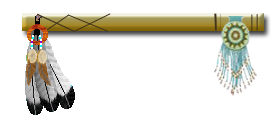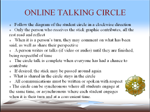Talking Circles
 Talking Circles or Circle Talks are a foundational approach to First Nations pedagogy-in-action since they provide a model for an educational activity that encourages dialogue, respect, the co-creation of learning content, and social discourse. The nuance of subtle energy created from using this respectful approach to talking with others provides a sense of communion and interconnectedness that is not often present in the common methods of communicating in the classroom. When everyone has their turn to speak, when all voices are heard in a respectful and attentive way, the learning atmosphere becomes a rich source of information, identity, and interaction. Talking Circles or Circle Talks are a foundational approach to First Nations pedagogy-in-action since they provide a model for an educational activity that encourages dialogue, respect, the co-creation of learning content, and social discourse. The nuance of subtle energy created from using this respectful approach to talking with others provides a sense of communion and interconnectedness that is not often present in the common methods of communicating in the classroom. When everyone has their turn to speak, when all voices are heard in a respectful and attentive way, the learning atmosphere becomes a rich source of information, identity, and interaction.
Talking Circles originated with First Nations leaders - the process was used to ensure that all leaders in the tribal council were heard, and that those who were speaking were not interrupted. Usually the Chief would initiate the conversation, with other members responding and sharing their perceptions and opinions of the topic under discussion. The process provides an excellent model for interaction within the learning environment as well. It is also very adaptive to any circle of people who need to discuss topics and make decisions together.
Object of Power
Several varied objects are used by different First Nations peoples to facilitate the talking circle. Some peoples use a talking stick, others a talking feather, while still others use a peace pipe, a sacred shell, a wampum belt, or other selected object. The main point of using the sacred object, is that whoever is holding the object in their hand has the right to speak. The circle itself is considered sacred. First Nations people observed that the circle is a dominant symbol in nature and has come to represent wholeness, completion, and the cycles of life (including the cycle of human communication). As well, many talking circles were traditionally "opened" through a prayer and smudging. A sacred space was facilitated by these reverent acts and observances.

Example of a Talking Stick
General Process

(Click image for larger view)
Online Talking Circles
Online course management systems provide several applications that can be used to apply the talking circle process within the virtual learning environment. Although presence is a key ingredient of effective talking circles, the teacher or guide can facilitate at least a semblance of web presence within the activity.
Some common applications that could be used to facilitate online talking circles include:
Although any of the above applications could be used to organize an online talking circle, there are some critical considerations that the teacher or facilitator must keep in mind. To quote David Osborn: (2003)
In her discussion of talking circles, Baldwin (1994) suggests the use of three principles concerning power questions: rotating leadership, shared responsibility, and reliance on the spirit. She also encourages individuals to practice speaking with intention, listening with attention and self-monitoring the impact of his or her contributions. Pranis et al. (2000), in keeping with the First Nations tradition, place strong responsibility on the elder or gatekeeper of the circle and refer to the gatekeeper as the servant of the circle process. They suggest that the gatekeeper’s qualities should include “community respect, knowledge of the community, a reputation for fairness and integrity, understanding of the practices and principles of peacekeeping (talking) circles, skill in facilitating difficult conversations, empathy and respect for others, and humility” (p. 35).
Circles are Unique
Discussions and Forums are commonly used in online education. The standard format includes a stem question or statement which then prompts the learner to comment or answer the question. Often, students are encouraged to respond to one another's discussion entry, and perhaps add further discussion to continue the dialogue.
The actual process of conducting an online discussion does lend itself to the common discussion method described above, which may or may not proceed in a respectful, enlightened sort of way. Frequently, students do not respond to one another's statements or if they do, it may be in a competitive or condescending manner. All too often, the discussion entries are written primarily for the teacher to read and to earn a grade in the course.
So, how can the discussion (whether it is on a forum, in a journal, on a blog or wiki, and so on) be conducted as a talking circle? First and foremost, is the issue of respect and "holding the centre of attention" where the others read and reflect on what the "speaker" has shared, before taking their turn to respond and share their own perspective.
Tutorial
Set up a Talking Circle to address the topic, "My Relationship to Place and the Natural World".
Preparation
1. Choose your dialogue medium: a blog, forum, wiki, and so on.
2. Prepare GUIDELINES for the talking circle. Click on graphic below for an example.

3. Prepare a GRAPHIC of a talking stick or feather (or other significant symbol or object) to use to signify the speaker. You may use the one we have created (see below), if you
like. 
Example of a Talking Stick Graphic
4. Organize a CIRCLE CHART with all of the students' names organized around it. Each student will have their turn, rotating in a clockwise manner. You can download the sample one below (pdf format) to use, if you like. This sample chart is also available as a Word or an Open Office Writer document.

Process
1. INTRODUCTION As the Gatekeeper of the Circle, introduce the general topic to be addressed in the talking circle and the Circle Guidelines, within the medium you have selected to use (forum, blog, wiki, chat, video, and so on). You may also choose to post a short prayer, blessing, or inspirational quote to help set the ambience of the circle.
In this case, the introduction might look something like:
My Relationship to Place and the Natural World
People interact with the natural world around them in individual and collective ways. Please tell us what the natural world means to you, and how you interact
with the geographical place where you live.
|
2. TALKING STICK Post or email the Talking Stick Graphic (or the graphic that you have elected to use as an Object of Honour) to the first person on your Talking Circle Chart.
3. CIRCLE BEGINS The first person should paste the graphic into the application (if possible - some mediums will not allow graphic insertion), then type in their heart-felt account of their experience with place and the natural world. This first person should then send the Talking Stick graphic to the second person on the Talking Circle chart.
4. CIRCLE CONTINUES The second person should then respond to the first person's shared work, and then engage in the same process as outlined in step 3 above.
5. CIRCLE CONTINUES EVEN MORE The third person would do the same as in step 4, but can choose which of the first two people he/she wishes to address (or they may choose to address both).
6. CIRCLE CONTINUES TO COMPLETION This process would continue around the circle until everyone has had a chance to express themselves within the Talking Circle. The circle can be synchronous where all students engage at the same time, or asynchronous where each student engages when it is their turn and at a convenient time.
Recommended Links
Diabetes Wellness: American Indian Talking Circles Facilitator's Manual
by Felicia Schanche Hodge et al, Center for American Indian Research and Education.
Talking Circles as a Metaphor and Pedagogy for Learning
by David A. Cowen and Kathy Adams, Miami University, Association of Leadership Educator's Conference, Lexington, KY, July 2002.
The "Talking Stick" Circle: An ancient tool for better decision-making and strengthening community by George Por.
Developed by June Kaminski, 2011
|